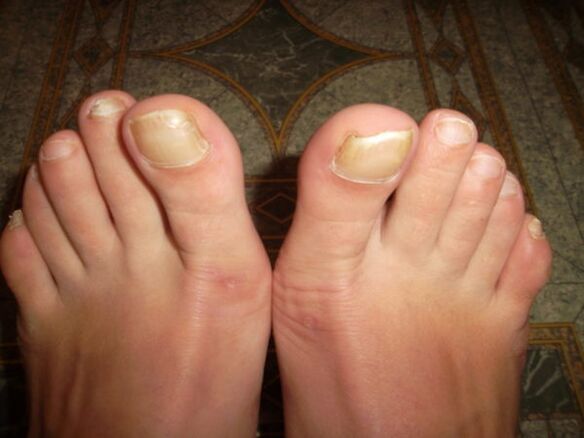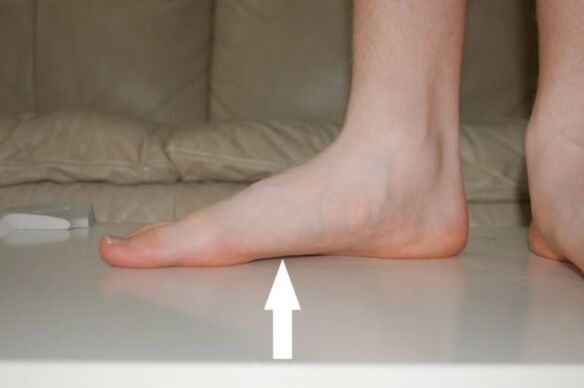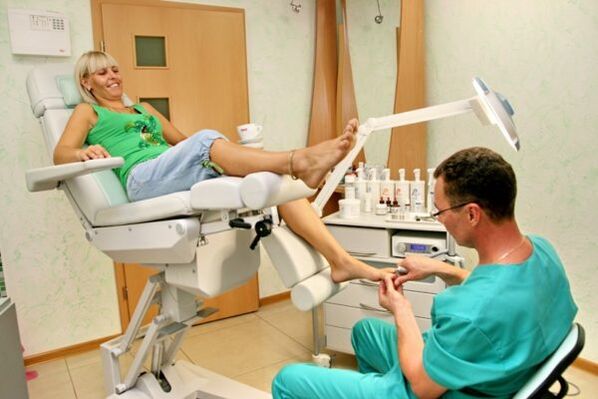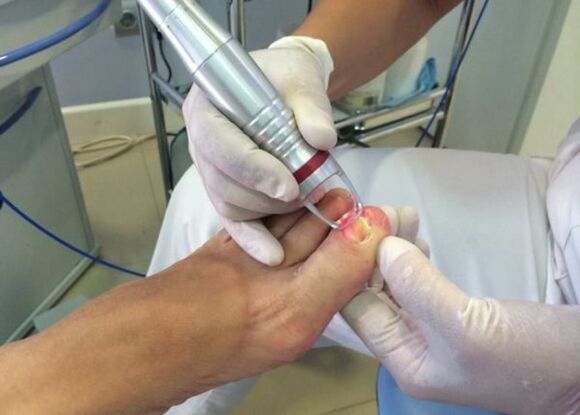Toenail fungus is called onychomycosis. Initially, the infectious process affects the thumb, but as it develops, it spreads to others. The disease goes through several stages. The earlier treatment is started, the easier it is to deal with the problem. This especially applies to the big toe of the lower limb - it has a large surface and size, so the degree of injury is significant.

Stages of onychomycosis
Nail fungus goes through several stages of development, each of which is characterized by certain symptoms. The following stages of disease development are distinguished:
- The original.At this stage, no visible pathological deviations are observed: the changes are still external. The nail plates on the fingers of the lower extremities lose their shine. White spots or streaks appear on the surface. In general, the nail looks healthy, the person does not feel pain or discomfort. If you recognize nail fungus at this stage, you can get rid of it quickly.
- Moderate or progressive.The structure of the nail is already undergoing pathological changes. The nail acquires a pronounced yellowish hue, peels and falls apart. An unpleasant smell also comes from the affected foot.
- Advanced or dystrophic stage.There is deep damage to the nails. In this case, the infectious process passes from the thumb to the rest. The entire surface of the nail plate is affected by the fungus and it peels off from the bed and becomes loose. The patient suffers from severe itching. Pressure on the affected areas causes a painful and pulsating sensation. For this reason, the patient should not wear closed shoes.
%20stage%20of%20onychomycosis.jpg)
In the third stage of the development of the infectious process, infection of the skin of the feet is possible. In this case, the fungus can be cured only with the help of complex therapy, which includes the use of local and systemic drugs (tablets for oral administration).
Reasons for the development of fungus on the big toe
The main reasons that cause the development of onychomycosis are:
- contact with a person who is a carrier of a fungal infection;
- neglecting hygiene rules;
- wearing someone else's shoes or tight shoes that don't fit;
- weakened immune system;
- visiting a bathroom, sauna, swimming pool or beauty salon, where non-disinfected instruments may be used;
- trauma to nails and surrounding skin;
- flat feet;
- long-term use of antibacterial drugs;
- hyperhidrosis (increased sweating in the feet);
- the presence of endocrine or immunological lesions;
- disorders in the circulatory system, which is especially important for elderly patients;
- phlebeurism;
- diabetes.

An important factor that increases the risk of developing onychomycosis is age. Elderly people suffer from poor blood flow to the extremities, which also increases the risk of developing fungal infections.
The causative agent of the disease gets on the nails or skin from infected objects or by contact with the carrier. The pathogen spreads rapidly, invading new areas. The fungus enters the subungual space through damaged areas of the nail plate or surrounding skin.
The fungus spreads quickly on the nail. The rate of advance exceeds the rate of plate growth. Soon the pathogenic microorganism reaches its goal and causes changes in the structure of the nail. It was found that men suffer from fungus 3 times more often. Nail plates are affected by types of fungi such as dermatophytes, mold and yeast.
When should you see a doctor?
At the first signs of a fungal infection, you should consult a doctor. You should not wait for obvious signs of the disease to appear - the formation of white spots and even mild itching in the area of the feet should be a reason to consult a specialist - a mycologist or a dermatologist.

Diagnostics
Diagnostic measures to identify the disease and its stage include:
- visual inspection of nail plates;
- taking a tissue sample from the affected nail;
- Cultural examination - inoculation of the material received by the patient on a nutrient medium in order to determine the type of microorganisms that have invaded the nails.
In some cases, the specialist makes a differential diagnosis and separates onychomycosis from diseases such as lichen planus, psoriasis and keratoderma.
Treatment of fungal nail infection in the early stages of development
If the disease is detected at an early stage, it will be much easier to deal with it. In this case, it is usually sufficient to use local agents that directly affect the affected nail.
In the first stage of mycosis, if no more than 50% of the nail plate is affected, the following drugs are prescribed:
- Varnish to be applied to the surface of the affected nails. This should be done twice a day, the total course of treatment will be one month. The product has contraindications, so it can only be used on the recommendation of a doctor.
- The product is produced in the form of a cream. The main active ingredient kills almost all types of fungi. The cream is applied 3 times a day, the course of treatment lasts about a month.
- A product impregnated with gypsum with a special composition. The adhesive strips are left on for 3 days and then removed. Special substances that cover the surface of the plaster help to soften the nail plate, so they can be easily removed with manicure tools or scissors.
- A medicine that contains a substance that destroys the fungus and stops its reproduction. It is recommended to smear the affected areas 1-2 times a day. The duration of the treatment depends on the condition of the nail plate and can range from two to four weeks.
All medications intended for the treatment of even mild forms of nail fungus must be prescribed by a doctor.
Advanced therapy of onychomycosis
In severe cases of fungi, as well as in the case of an ongoing infectious process, complex treatment is indicated. Systemic antifungal agents must be prescribed if there are no contraindications. The patient is prescribed the following drugs:
- A systemic antibiotic from the triazole group in tablet form. The active substance of the drug reaches the location of pathogenic microorganisms and has a fungicidal effect.
- A drug from the imidazole group that inhibits the development of pathogenic microorganisms and destroys them. The course of treatment and dosage is determined by the attending physician. The product causes unwanted reactions.
- A drug from the allylamine group that has a fungicidal effect. The active substance gradually accumulates in the layers of the nail plate, which makes it possible to destroy even those fungi that are quite deep.
Also, with advanced nail fungus, the procedures are effective for removing the infected plate. This can be done in the following ways:
- Surgical excision.This method involves lifting the plate with a sharp surgical instrument and removing it from the bed. After the operation, a bandage is applied. The surgical method is traumatic and rarely used. Instead, minimally invasive methods are practiced.
- Plaque removal using chemicals, encouraging rapid exfoliation of the affected nail. In this case, the problem area is treated with a special solution, wait for the drug to start working, and then use products that help to quickly remove the plaque from the nails.
- Laser treatment.This is a modern, painless method that will quickly get rid of nail fungus. The laser acts on the plate, bringing it to high temperatures as quickly as possible. The beam penetrates deeply and neutralizes pathogens. The method is bloodless and absolutely safe, as it does not cause burns.

In the advanced stages of onychomycosis, it is necessary to strictly follow the doctor's recommendations, because the lack of adequate treatment increases the risk of generalized damage to the organism by fungal infection.
Traditional methods
Nail fungus can also be cured with traditional medicine. Such methods are additional in nature and cannot be the basis of therapy. The most popular folk remedies include:
- Onion pulp.It is necessary to grate several onions and apply the obtained mass on the affected nails. Secure the top with a bandage. Leave on for 15-20 minutes, rinse.
- Hydrogen peroxide.First, soak the affected feet in a water bath to soften the nails as much as possible. Then remove the top layer from the plate. Dip a piece of gauze in hydrogen peroxide and wrap the phalanx of the finger with the affected nail, grasping the current lesion. Leave for 40-50 minutes. You can repeat the procedure up to twice a day.
- Apple vinegar.It is important to use a natural product. Take 2 tablespoons of vinegar and add the same amount of vodka and a tablespoon of glycerin. Dip a cotton swab in the resulting mixture and apply to the nails for 15 minutes. Repeat 4 times a day.
Traditional recipes help alleviate the severity of disease symptoms and eliminate discomfort, but they are unable to destroy the causative agents of the disease.
Course of the disease and features of treatment of nail fungus in children
Onychomycosis is rare in children. The main cause of the disease is weak immunity due to incomplete formation. Symptoms of onychomycosis in children are:
- the plate loses its natural pink color, gray or white spots appear on the surface;
- unevenness and bumpiness of the nail plates;
- brittle and brittle nails;
- redness and swelling of the skin around the child's infected nail.
For the treatment of nail fungus in children, only topical preparations, such as a spray, varnish or cream, are usually used. If necessary, systemic drugs are also prescribed. Oral antifungal drugs should only be prescribed by a doctor.
Features of treatment of pregnant and lactating women
During pregnancy, there is a high risk of developing onychomycosis if the woman has already suffered from the disease and has not completely cured it. This is due to the weakening of the immune system that occurs during pregnancy.
It is important to treat the fungus on time, because in severe cases it creates a risk of bacterial infection that endangers the health of the mother and the fetus. Systemic drugs should not be used during pregnancy, as they have a high level of toxicity.
During pregnancy and breastfeeding, local medicines should be used, but only those that are safe for the expectant mother and her baby. These include sulfur-salicylic ointment.
Treatment of the elderly
In the elderly, a decrease in immunity is a natural phenomenon associated with aging that creates additional risks for the development of onychomycosis. In this case, the expert is also careful when choosing a drug to treat nail fungus.
Systemic drugs are prescribed if the disease lasts a year or more, as well as for extensive lesions and degenerative changes on the nails.
Elderly patients are most often prescribed systemic antifungal agents from the group of allylamines and triazoles.
Preventive measures
If you have signs of fungus on your little finger or thumb, contact your doctor immediately. But measures can be taken to prevent the development of this disease. The following recommendations should be followed:
- wash your feet at least once a day;
- wash your socks every day and wear clean ones;
- if you sweat excessively, use special deodorants for feet;
- Wear shoes of the correct size, they should not be too tight and should be washed daily;
- use only personal hygiene products, as well as manicure and pedicure tools;
- when visiting the pool, beach, sauna, use personal rubber shoes;
- After going to the pool, sauna, wash your feet with soap and water, if necessary use pharmaceutical preparations for prevention.
Toenail fungus is a disease that is quite difficult to cure in an advanced stage. At the first symptoms, you should consult a doctor. Treatment depends on the degree of development of onychomycosis: in the initial phase, local drugs are sufficient; once initiated, systemic antifungal agents are required.

















